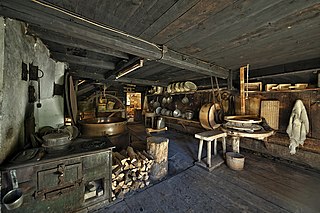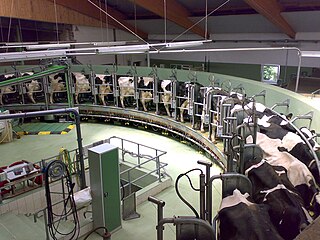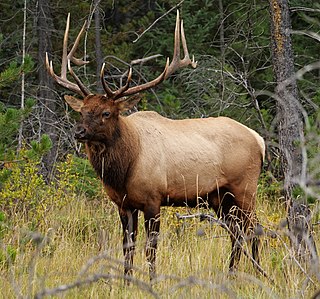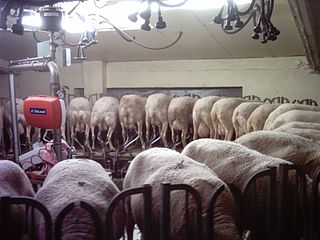

Moose milk, also known as elk milk, refers to milk produced by moose (Alces alces). Though it is most commonly consumed by moose calves, its production has also been commercialised in Russia, Sweden and Canada.


Moose milk, also known as elk milk, refers to milk produced by moose (Alces alces). Though it is most commonly consumed by moose calves, its production has also been commercialised in Russia, Sweden and Canada.
Moose milk is high in butterfat (10%) and solids (21.5%), according to data collected on Russian moose; research into American moose milk is in a less advanced state than in Russia, but appears to indicate that American moose have even higher concentrations of solids in their milk. [1] Moose lactate between June and August; conditional on a good supply of high-quality forage, nutrient and fat concentrations in the milk typically increase during the first twenty-five days of lactation, which are considered the peak period; nutrients, fat, and mineral element concentrations decrease for the remainder of the lactation period. [2] However, compared to cow milk, moose milk still has much higher levels of aluminium, iron, selenium, and zinc. [3]
Moose milk is commercially farmed in Russia; one sanitorium, the Ivan Susanin Sanitorium, even serves moose milk to residents in the belief that it helps them recover from disease or manage chronic illness more effectively. [4] Some Russian researchers have recommended that moose milk could be used for the prevention of gastroenterological diseases in children, due to its lysozyme activity. [5] The Elk House (Älgens Hus) farm in Bjurholm, Sweden, run by Christer and Ulla Johansson is believed to be the world's only producer of moose cheese. It has three milk-producing moose, whose milk yields roughly 300 kilograms of cheese per year; the cheese sells for about US$1,000 per kilogram. [6] A disturbed moose cow's milk dries up, so it can take up to 2 hours of milking in silence to get the full 2 litre yield. [7] Russian moose researcher Alexander Minaev had also previously tried to make moose cheese, but he stated that, due to the milk's high protein content, the cheese became hard far too quickly. He was not aware of any attempts to make moose ice cream. [8]

Milk is a white liquid food produced by the mammary glands of mammals. It is the primary source of nutrition for young mammals before they are able to digest solid food. Immune factors and immune-modulating components in milk contribute to milk immunity. Early-lactation milk, which is called colostrum, contains antibodies that strengthen the immune system and thus reduce the risk of many diseases. Milk contains many nutrients, including protein and lactose.

The moose or elk is the only species in the genus Alces. It is the largest and heaviest extant species of deer. Most adult male moose have distinctive broad, palmate antlers; most other members of the deer family have antlers with a dendritic ("twig-like") configuration. Moose typically inhabit boreal forests and temperate broadleaf and mixed forests of the Northern Hemisphere in temperate to subarctic climates. Hunting and other human activities have caused a reduction in the size of the moose's range over time. It has been reintroduced to some of its former habitats. Currently, most moose occur in Canada, Alaska, New England, New York State, Fennoscandia, the Baltic states, Poland, Kazakhstan, and Russia.

A dairy is a place where milk is stored and where butter, cheese and other dairy products are made, or a place where those products are sold. It may be a room, a building or a larger establishment. In the United States, the word may also describe a dairy farm or the part of a mixed farm dedicated to milk for human consumption, whether from cows, buffaloes, goats, sheep, horses or camels.

Dairy farming is a class of agriculture for long-term production of milk, which is processed for eventual sale of a dairy product. Dairy farming has a history that goes back to the early Neolithic era, around the seventh millennium BC, in many regions of Europe and Africa. Before the 20th century, milking was done by hand on small farms. Beginning in the early 20th century, milking was done in large scale dairy farms with innovations including rotary parlors, the milking pipeline, and automatic milking systems that were commercially developed in the early 1990s.

Bovine somatotropin or bovine somatotrophin, or bovine growth hormone (BGH), is a peptide hormone produced by cows' pituitary glands.

Dairy cattle are cattle bred for the ability to produce large quantities of milk, from which dairy products are made. Dairy cattle generally are of the species Bos taurus.

Goat milk is the milk of domestic goats. Goats produce about 2% of the world's total annual milk supply. Some goats are bred specifically for milk. Goat milk naturally has small, well-emulsified fat globules, which means the cream will stay in suspension for a longer period of time than cow's milk; therefore, it does not need to be homogenized. Eventually, the cream will rise to the top over a period of a few days. If the milk is to be used to make cheese, homogenization is not recommended, as this changes the structure of the milk, affecting the culture's ability to coagulate the milk and the final quality and yield of cheese.

The elk, or wapiti, is one of the largest species within the deer family, Cervidae, and one of the largest terrestrial mammals in its native range of North America and Central and East Asia. The word "elk" originally referred to the European variety of the moose, Alces alces, but was transferred to Cervus canadensis by North American colonists. The name "wapiti", derived from a Shawnee and Cree word meaning "white rump", is also used for C. canadensis.

Pechora-Ilych Nature Reserve is a Russian 'zapovednik' in the Komi Republic, Russia. It currently occupies 7,213 square kilometers and forms the core of the World Heritage Site Virgin Komi Forests.

The dry matter or dry weight is a measurement of the mass of something when completely dried.

Kerry cattle are a rare breed of dairy cattle, native to Ireland. They are believed to be one of the oldest breeds in Europe, probably derived from small black cattle brought to Ireland by Neolithic man. They were probably also the first cattle bred mainly for milk production, with other breeds being developed mainly for draught and meat. The climate of southwestern Ireland was suitable for milk production year-round, and the Celts also stored milk in the form of cheese and butter.

Sheep's milk is the milk of domestic sheep. It is commonly used to make cultured dairy products such as cheese. Some of the most popular sheep cheeses include feta (Greece), ricotta (Italy), and Roquefort (France).

The Lacaune is a breed of domestic sheep originating near Lacaune in southern France. The native region of these sheep is the Tarn and Aveyron departments and surrounding areas. This region is collectively known as the "Roquefort Sector" which references the milk collection area. The Lacaune is the most widely used dairying sheep breed in France, with a population of about 800,000 ewes. Notably, it is the predominant breed used in the production of Roquefort cheese in France.

Norwegian Red is a breed of dairy cattle developed in Norway since 1935. Since the 1970s, breeders strongly emphasized functional and production traits resulting in excellent production combined with world-leading performance in health and fertility traits. Norwegian Red cows can have either a red and white or black coat and have a high proportion of genetically polled animals.
Moose cheese is cheese created from moose milk. Varieties of moose cheese are produced in Sweden by Christer and Ulla Johansson at their location called "Moose House" or "Elk House". Three varieties of moose cheese are produced.

Pig milk is milk from pigs, and is typically consumed by piglets. It is similar in composition to cow's milk, though higher in fat and more watery. Pig milk is seldom obtained for human uses and is not considered to be a viable agricultural product. Several attempts have been made to produce pig milk cheese, some of which have been successful.

Goat farming involves the raising and breeding of domestic goats as a branch of animal husbandry. People farm goats principally for their meat, milk, fibre and skins.

Moose cavalry are military units of cavalrymen mounted on moose rather than the more usual horses. Some sources state that in 17th-century Sweden Charles XI trialled the use of moose as a replacement for horses, which had to be imported, but this is disputed. The use of moose cavalry by the Soviets in the Winter War of 1939 and 1940 is also reported but seems to stem from a 2010 Popular Mechanics April Fools' Day article.

A dry cow refers to a dairy cow that is in a stage of their lactation cycle where milk production ceases prior to calving. This part of their lactation cycle is referred to as the cows dry period and typically last between 40 and 65 days. Dry cows are typically divided into two groups: far-off and close-up. Once the cow has entered this stage, producers will seal the cows teat while following a veterinarian recommended, dry cow therapy for their herd. This dry period is a critical part of their lactation cycle and is important for the cows health, the newborn calf and future milk production, as it allows the cow time to rest, eat and prepare for birth. During this time, the cow will produce colostrum for the newly born calf.